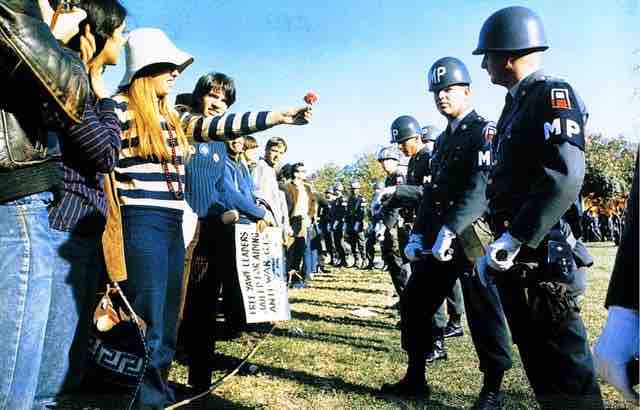The New Left
In the United States, the "New Left" was the name loosely associated with liberal, sometimes radical, political movements that took place during the 1960s, primarily among college students. The New Left was a loosely organized, mostly white student movement that protested the Vietnam War and advocated for democracy, civil rights, and various types of university reforms.
The New Left opposed what it saw as the prevailing authority structures in society, which it termed "The Establishment"; those who rejected this authority became known as "anti-Establishment". The New Left drew inspiration from black radicalism, particularly the Black Power movement and the left-wing Black Panther Party. The New Left did not seek to recruit industrial workers but rather concentrated on a social activist approach to organizing, convinced they could be the source for a better kind of social revolution. The New Left was also marked by the advent of the modern environmentalist movement, which clashed with the Old Left's disregard for the environment in favor of preserving the jobs of union workers.
Students for a Democratic Society (SDS)
The organization that came to symbolize the core of the New Left was the Students for a Democratic Society (SDS). By 1962, the SDS had emerged as the most important of the new campus radical groups; soon it would be regarded as virtually synonymous with the New Left. The organization developed rapidly in the mid-1960s before dissolving at its last convention in 1969.
The SDS became the leading organization of the anti-war movement on college campuses during the Vietnam War. As the war escalated, the membership of the SDS also increased greatly as more people were willing to scrutinize political decisions in moral terms, and the people became increasingly militant. As opposition to the war grew stronger, the SDS became a nationally prominent political organization, and opposition to the war became an overriding concern that overshadowed many of the issues that had originally inspired the SDS.
Early Years of SDS and Protests: 1962–1968
On October 1, 1964, the University of California, Berkeley became the site of the first widespread student protests. Student protests called the Free Speech Movement took place during the 1964–1965 academic year under the informal leadership of students Mario Savio, Art Goldberg, Jackie Goldberg, and others. In protests that were unprecedented in scope at the time, students insisted that the university administration lift the ban of on-campus political activities and acknowledge the students' right to free speech and academic freedom. On December 2, 1964, on the steps of Sproul Hall, Mario Savio gave a famous speech. The demonstrations, meetings, and strikes that resulted all but shut the university down, and hundreds of students were arrested.

Beginning of SDS and Student Protests
Mario Savio's free speech protest at the University of California, Berkeley, marked the beginning of student rebellions nationwide.
Shortly after, in February of 1965, President Johnson dramatically escalated the war in Vietnam by bombing North Vietnam and introducing ground troops in the South. Campus chapters of the SDS all over the country started to lead small, localized demonstrations against the war. The media began to cover the organization and the New Left.
The fall of 1967 saw a great escalation of the anti-war actions of the New Left. The school year started on October 17 at the University of Wisconsin in Madison, with a large demonstration against the university's complicity in the war in allowing military recruiters on campus. Peaceful at first, the demonstrations turned into a sit-in that was violently dispersed by the Madison police and riot squad, resulting in many injuries and arrests. A mass rally and a student strike then closed the university for several days. After conventional civil rights tactics of peaceful pickets seemed to have failed, the Oakland, California Stop the Draft Week ended in mass skirmishes with the police. The huge October 21 March on the Pentagon saw hundreds arrested and injured. Night-time raids on draft offices began to spread.
Ten Days of Resistance
In the spring of 1968, national SDS activists led an effort on campuses called "Ten Days of Resistance." Local chapters cooperated in rallies, marches, sit-ins, and teach-ins, and the effort culminated in a one-day strike on April 26. About one million students stayed away from classes that day in the largest student strike in the history of the United States. It was largely ignored by the New York City-based national media, which focused on the student shutdown of Columbia University in New York, led by an inter-racial alliance of Columbia SDS chapter activists and Student Afro Society activists. As a result of this publicity, "SDS" became a household name in the United States. Membership in SDS chapters around the United States increased dramatically during the 1968-69 academic year.
The Disintigration of SDS
In 1968 and 1969, the SDS began to split under the strain of internal dissension and an increasing turn towards Maoism. Along with adherents known as the New Communist Movement, some extremist factions also emerged, such as the Weather Underground Organization. In the summer of 1969, the 9th SDS national convention was held at the Chicago Coliseum, with some 2,000 people attending. The various factions present, such as the Worker Student Alliance (WSA) and Progressive Labor (PL) members, were divided as to what the mission and purpose of SDS should be. The convention ultimately fell apart, and in the fall of 1969, many of the SDS chapters split up or disintegrated.

Anti-War Protestors
A demonstrator offers a flower to military police at an anti-Vietnam War protest in Arlington, Virginia, 21 October 1967